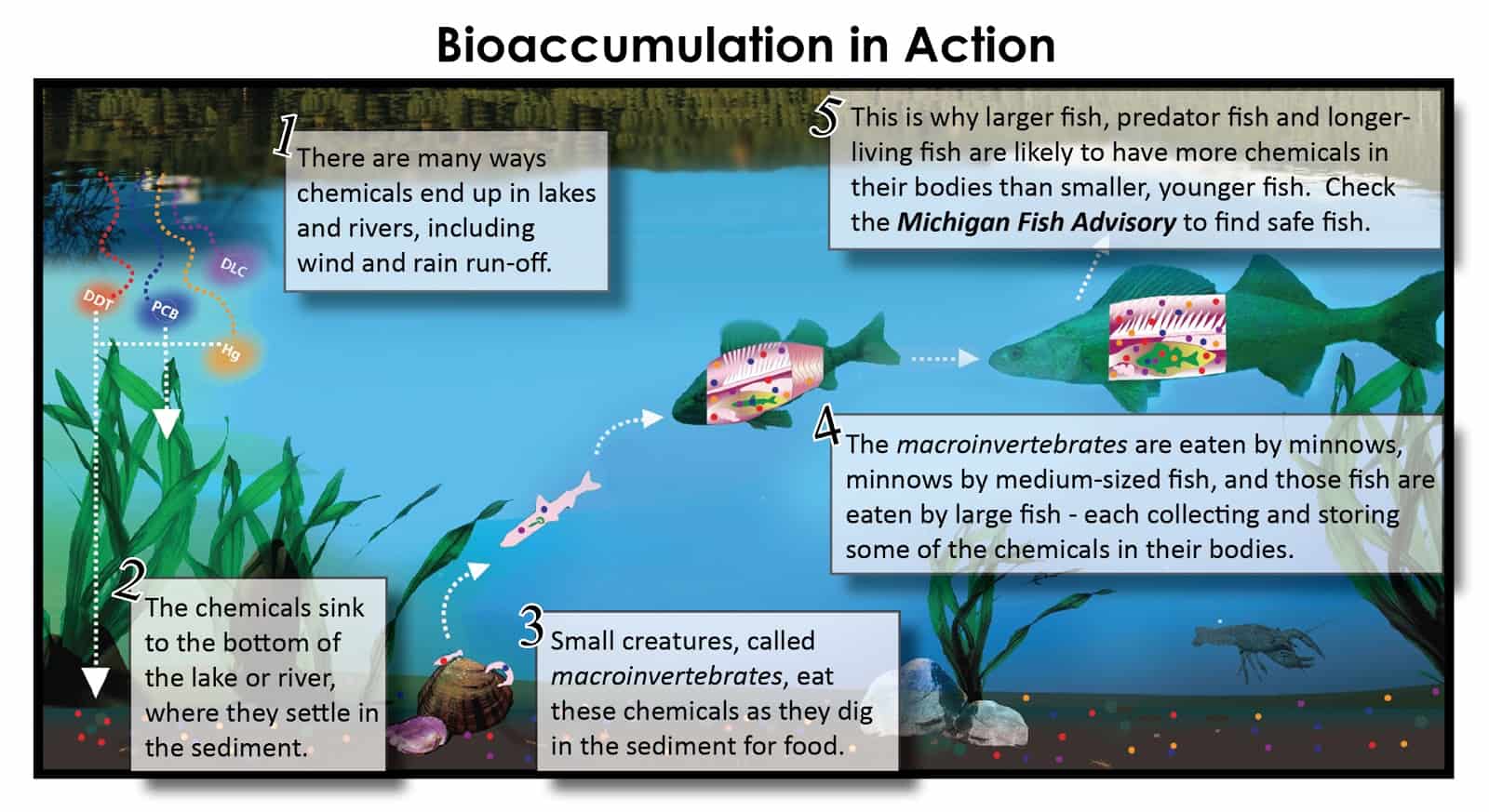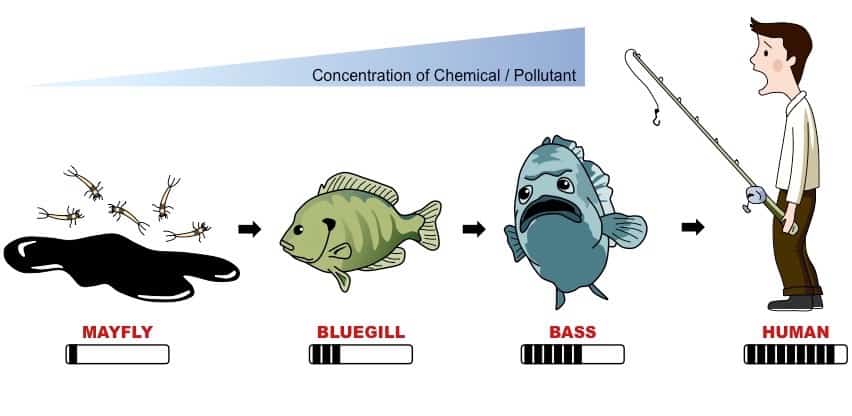A well-balanced diet is essential for good health and fish has always been on the menu until recent studies that show how fish absorb the built-up of toxic chemicals through the food chain over a period of time called Bioaccumulation and pass them on to us. How Does Bioaccumulation in Fish Happen?
Bioaccumulation in fish happens when:
- Chemicals end up in oceans, rivers, etc.
- Settle to the bottom sediment
- Tiny creatures dig in the sediment & eat the chemicals
- Creatures are eaten by minnows
- Minnows are eaten by fish
- Larger fish eat the smaller fish & all the stored chemicals
- Humans eat the larger fish
Fish are a great source of low-fat protein and have heart-healthy Omega 3s vitamins and fatty acids but some fish are worst than others when it comes to containing Persistent Chemicals.
Persistent Organic Pollutants Examples
Persistent chemicals are chemicals that are very stable and don’t break down over time. Chemicals such as PCBs, DDT, dioxins, and mercury are all Persistent Chemicals. Because chemicals like these don’t break down and go away it becomes a huge problem with the fish or wildlife because they will start to build up in their system. If you eat the fish or the wildlife then the chemicals will be stored and bioaccumulated in your body. That can lead over time to health problems.
The problems are not the fish, it’s the toxic chemicals like mercury and other toxins that are injected into the air, water, and land that end up in the fish we eat. Mercury is extremely bad for consumption and can be found in different fish that scientist has identified as having more risk than others.
Even though the EPA and governing agencies have done a good job at eliminating the source of heavy metals like mercury from the environment, the Persistent Chemicals that entered the ecosystem years before still remain and will be there for a long time to come.

How Does Mercury Get Into the Water
We have known for a while that the heavy metal that makes the most impact on fish is Mercury. Fish that are in oceans, rivers, and bays are exposed to it. Now It’s not just mercury but a host of chemicals and even micro-plastics that are now being found in the muscles and livers of fish.
These plastics and chemicals are bioaccumulated into the fish over periods of time. Most of this information from testing how tiny pieces of plastics and other chemical pollutants are built-up in fish over a long time period is a new type of science.
The tiny pieces of plastics actually are acting like sponges for other nastier chemicals that once get inside aquatic life can be absorbed into the fish and passed on through the food chain. From the smaller to the bigger species who live longer and absorb more toxins.
Our oceans and rivers have been a toilet for a long time and the time is just catching up to us. Heavy metals like mercury are eventually removed from the food chain when they sink into the deep ocean or become bound up in the soil, but that takes centuries.
So we are stuck with the toxins we have recently emitted for some time. One study found that 83 percent of the surface ocean’s mercury ended up there from human activities.
The scientist has known for decades that the risk of chemicals moving up the food chain as predators fish eat the smaller fish and we eat the predator species. This is why the fattest and largest fish like Tuna and Swordfish end up with the most mercury and PCBs (polychlorinated biphenyls) and other toxins that are not as easy to measure as mercury. That’s pretty concerning being that Tuna fish was the highest consumed fish from the ocean consumed by people here in the States.
Mercury comes from a broad spectrum of industries throughout the world. From the Gold Mining to the Cement business. The burning of coal is the largest single anthropogenic source of mercury air emissions, having more than tripled since 1970. Coal-burning for power generation is increasing alongside economic growth. Releases from power plants and industrial boilers represent today roughly a quarter of mercury released into the atmosphere.
Household burning of coal is also a significant source of mercury emissions and a human health hazard. Although coal contains only small concentrations of mercury, it is burnt in very large volumes and has been for many years all over the globe.
How Does Mercury Affect Fish
First Identify the main types of fish that carry the most toxins, especially mercury which became the most abundant and dangerous heavy metal contaminant. Then avoid a few key species like the King mackerel, marlin, orange roughy, shark, swordfish, tilefish, ahi tuna, and bigeye tuna who all contain high levels of mercury. The higher levels are more vulnerable to part of the population like women who are pregnant or nursing or who plan to become pregnant within a year and are told to avoid eating these fish. Along with children younger than six.
Popular Sushi is normally prepared from the big predator fish that are at the top of the food chain, which makes them likely candidates for bigger, longer-living fish that are high in the Bioaccumulation cycle.
Fish and shellfish like eel, salmon, crab, and clam are lower in mercury. Smaller is key when describing fish on the bottom of the Food Chain and the ones less likely to be carrying larger amounts of toxins. The NRDC recommends Salmond, Pollock, Catfish, Canned White Tuna and Shrimp, and sardines as very low in contaminants, especially mercury.
The Federal Government and each State has the power to alert people with Fish Advisory Programs in the event consumers should avoid eating certain species of fish or shellfish caught from specific water bodies or types of water bodies that include lakes, rivers, or coastal waters due to contamination.
Fish tissue Data is collected and evaluated in the States for the State Fish Advisories. New communication between States in the USA study samples and decide how to process the testing and whether or not it poses a threat and to what communities around the country.
What’s a Fish Advisory?
A Fish Consumption Advisory is a recommendation to limit or avoid eating certain species of fish or shellfish caught from specific water bodies or types of water bodies (e.g., lakes, rivers, or coastal waters) due to contamination. Fish Advisories are listed state by state all around the country. Current and historical information is listed here.
Mercury and other pollutants that are emitted up in the air or through waterways from factories around the other side of the world can end up in the seafood you are eating. It can end up in rivers, bays then the ocean then ingested into small organisms working its way up to small and larger fish and shellfish eventually onto your kitchen table.
International Organizations
Concern for the ongoing problems with exposure to mercury poisoning of fish lead to The Global International Partnership in 2005 that exists today with a global awareness of this serious worldwide environmental threat.
The Global Mercury Partnership
The UN Environment Global Mercury Partnership consists of stakeholders from governments, industry, NGOs, and academia who are dedicated to protecting human health and the environment from the impacts of mercury, and to reducing global environmental releases of mercury. Initiated in 2005 by a decision of the UN Environment Governing Council, the Partnership played an important role in catalyzing global action on mercury and offering information, capacity-building, and awareness-raising in support of international negotiations to establish a legally-binding instrument on mercury.
The Partnership has been successful since then of:
- Reducing mercury in artisanal and small-scale gold mining
- (ASGM)Mercury control from coal combustion
- Mercury reduction in the Chlor-alkali sector
- Mercury reduction in products
- Mercury air transport and fate research
- Mercury waste management
- Mercury supply and storage
- Mercury releases from the cement industry
The good news from all this study on fish and mercury is that up to 95% of mercury released from power plants can be reduced. This can be achieved by improving coal and plant performance and optimizing control systems for other pollutants. The bad news is, that mercury, like PCPs and many others, is regarded as a Persistent chemical that won’t break down for years to come. Then there is plastic!
Identifying and Stopping the source is a great thing but the contaminants that are already in the sediments of lakes, rivers, and oceans will continue to enter the smallest of macroinvertebrates that will be eaten up by minnows, that will be eaten by the bigger older predatory aquatic fish or wildlife that will be consumed by humans at the top of the food chain. That is Bioaccumulation in Action.
JimGalloway Author/Editor

References: The Mercury Partnership Program
